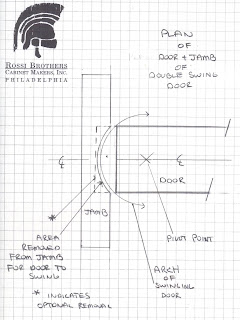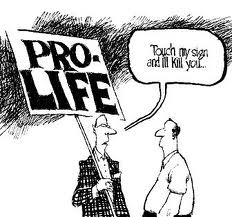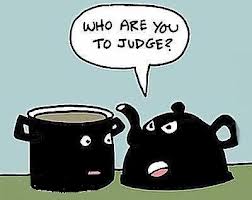By Victor Rossi
In
many kitchens and other doorways throughout the house or apartment there is
sometimes the need for the convenience of a double swing door. The type I'm
referring to is the door hung on the double acting pivot hinge. This hinge is mounted in the top and bottom
edge of the door and the door is usually hung in the center of the jamb. There
are several styles on the market but the principal is the same.
The
one drawback I have found is the rounding over of the back edge of the door to
clear the jamb on the hinge side. This is considered acceptable for this type
of installation situation and even recommended by the manufactures of the
hinge. When making a custom door,
especially a veneered door, I find it unsightly and interferes with clean even
spacing between door and jamb.
Rossi Brothers
Cabinet Makers, Philadelphia, PA.
Here
at my shop (Rossi Brothers Cabinet Makers), since we package our doors and
jambs, we have an alternative. We route the jamb to receive the swing of the
back edge of the door. This is a much cleaner look and the door does not appear
different from the other doors in the house.
The
way this is done is to make a full scale drawing of the hinge side of the door
with reference to the jamb allowing a 1/8" space between the door and the
jamb.
You
locate the pivot point of the hinge in the door then with a compass swing an
arch that just clears the corners of the back edge of the door. The arch marked
on the jamb section of the drawing is the area to be routed out of the jamb.
You could allow a bit more clearance in depth and width just to be safe, but
don't make the width wider than the thickness of the door. The depth can be
much deeper than needed.
On
a double swing door the pivot point must be in the center of the thickness of
the door. The distance of the pivot point must be at least the same distance
from the back edge of the door, but can be greater. The farther from the back
edge of the door the less of a rout needed in the jamb.
Some
hinge manufactures limit the distance their hinge can be set from the back edge
of the door. (With a single direction swing there is no limit but that is for a
different situation than being described here) We set the door members and the
jamb head member of the hinges in the shop but the floor member needs to be set
in place on site, unless we are using a threshold. The floor member is set in
relation to the location of the pivot point in the head by using a plumb bob,
or these days a laser. Most finish carpenters I've worked with have no problem
with this method of installation. They almost always complement the results and
I've been asked to repeat it for them on some of their other installations.
This
is only one use of this principle of installation. It is my intention to
explain how to execute the various uses of this principle and of course it's
limitations.
Pivot
Hinges and Secret Panels
A
situation where the pivot hinge also works well is the secret panel. I was given a situation where the architect
wanted the center panel to open as a door to access a hidden cabinet. The
problem was the panel was a recessed panel with a raised moulding where the
panel meets the stiles and rails. The architect didn't want just the recessed
section of the panel to open but the panel with the moulding. In other words he
wanted the whole panel to open at the point where the panel and its moulding meet
the stiles and rails. A soss hinge was spec’ed, but anyone who is familiar with
a soss hinges and looking at the drawing will see that a soss hinge won't work
for that application.
The
position of the pivot point is determined by the clearance need for the door to
operate. The pivot point distance from the face has to be equal or less than
the distance from the back edge. A
little trial and error is sometimes needed to get the best pivot point and
achieve the proper end result. In some case the pivot point distance from the
edge can be great enough to eliminate any removal of material from the stile.
Keeping in mind the farther the distance from the edge, when opened, the deeper
the door moves into the cabinet and the farther the open door moves into the
opening space.
The
pivot hinge is also is used in many cabinet situations where a concealed hinge
is wanted. This was the original
concealed method used in most antique furniture. Today in cabinetry this
concealed method has been more commonly replaced by the European style hinge
and in some instances the "soss" hinge.
The
advantage of the European style hinge is its ease of installation and it is not
limited to an inset installation but can be used for complete overlay. Its
disadvantage is thick doors, heavy doors and doors that are wider than they are
high. In all three of these disadvantages mentioned the doors will sag and tend
to not stay in proper alignment. If you are reproducing an antique or a piece
of furniture from the Deco period the only method of a concealed hinge then was
the pivot. To use a "soss" or European style hinge would not be
proper for a reproduction.
To
use a pivot hinge you must understand what is necessary for its
installation. Since the hinge is mounted
at the top and the bottom of the door it needs a place to mount the cabinet
member of the hinge. It needs a rail or top above the door and a rail below the
door. The straight pivot hinge can only work in a inset situation. It will function in a flush or set back
position. The point of pivot determines the clearance needed for the door. This
principle is one of the few that can be used for a Bombay shaped door.














